Alfred v2.4 officially brings in OS X Yosemite compatibility and theming improvements, as well as some general improvements and bug fixes.
While Alfred has been working fine on Yosemite since the first OS X 10.10 beta, this latest release adds improvements and fixes the minor quirks some users have experienced in Yosemite.
Theming Improvements
We've made loads of theming improvements and have added two gorgeous Yosemite-style themes to the default selection of themes, with a light and a dark version using Helvetica Neue Light for a swish fresh look.

If you're a Powerpack user, you can customise the themes to get a slick semi-transparent background by turning down the opacity of the background and setting the new window blur option to medium in the Appearance Options.
Amongst the many other theming improvements, you can also now change when to show the result subtext, allowing you better control over how minimalist your theme is; Show the result subtext for the selected row or only for alternative actions.
Fuzzy Matching for File System Navigation
This new option makes browsing the file system even easier by introducing fuzzy matching; While browsing your file system navigation results, "CS" will bring up ColorSnapper or "GC" for Google Chrome. This setting is on by default and matches file results more loosely for a more natural search.
If you preferred the old bash/shell style navigation, you can turn off fuzzy matching in Alfred's Features > File Search > Navigation preferences.
Improvements to Workflows
Amongst the many workflow improvements, you'll find some useful new alfred_ environment variables when running scripts, which provide commonly required Alfred information. We've included more details on these variables in this support Knowledge Base.
We've also added support for proxies (http_proxy and https_proxy) and the proxy exception list. You can enable proxy support in Alfred's Advanced preferences.
Many more improvements and bug fixes
Have a look at the change log for the full list of improvements and fixes. And don't forget to update to v2.4 in-app through the Update tab or download it from our website.
There's something almost magical about Alfred learning to predict the result you want most when you type a few characters; It's the perfect and easy way to search for apps, folders, contacts and other results that live on your Mac.
However, sometimes, you need to do a quick web search. The usual way to do this would be to type "wiki" followed by your search term to launch the relevant Wikipedia page, or type "youtube" to search YouTube. But there IS an even quicker way to search your most-used sites: Fallback searches. They're the list of search options you see when you search for a keyword that doesn't match a result on your local Mac.
The default fallback searches are Google, Wikipedia and Amazon, as these are the most commonly used web searches. If you're a Powerpack user, you can customise these to your favourite sites or actions instead.
Here are my fallback searches; Wikipedia, the OS X dictionary, YouTube, Amazon and Etsy. (and yes, I'm searching for beer)

You can change your fallback searches in Alfred's preferences under Features > Default Results, where you'll see a "Fallback Results" button. Use the + button to add web searches, custom searches and workflow triggers. You can then drag and drop them to reorder them.

My fallbacks are a mix of default web searches (Wikipedia, YouTube and Amazon), custom searches (Etsy) and workflow triggers (Dictionary search).
Create custom searches for your favourite websites that aren't part of Alfred's default web searches, or create fallback triggers in workflows for actions like "Show definition for {query}".
Once you've arranged these in the order you want, your fallback searches will appear anytime you type a keyword where Alfred doesn't find a local search result! :)
Enjoyed this post? We've published more tips and tricks on making the most of Alfred.
Over the past year, we've rolled out our corporate licensing scheme to many companies who love Alfred. Providing staff members with the Powerpack through this license scheme allows you to create workflows for in-house use without having to worry whether each team member has already bought a license.
Whether you're a designer, developer, copywriter or anyone where efficiency plays a part in what you do, you'll benefit from the advanced features the Powerpack brings you. From workflows and custom hotkeys to Clipboard History and 1Password bookmarks integration, there are so many ways to improve the way you manage your everyday work tasks.
How does the corporate license differ from standard licenses?
- Available to business teams exclusively
- Discount ranging from 10% to 50% depending on the number of volume of seats purchased
- Company-wide license means that there is no need to juggle individual license codes for each staff member
If you think your team would benefit from using the Powerpack, contact us for more details on corporate licensing. What could be better than getting your boss to buy you a Powerpack license? :)
Following the release of OS X Yosemite Preview 4 as a public beta, we're bringing forward the first Alfred v2.4 release. This build has better support for saving Alfred's preferences, which were affected by a few changes introduced in Preview 4, as well as a whole host of amazing new improvements including two brand new Yosemite themes.
If you're using Yosemite Preview 4, we would love for you to help us test this build. Keep in mind that this is a development build and is essentially untested, but we've been using it over the past few weeks and it's perfectly stable.
You can update to the latest pre-release in-app or download the beta Alfred v2.4 build 277 directly to take advantage of these improvements. Once the build has been thoroughly tested, we'll put it out to general release.
You can now update to the latest release in app or download Alfred directly from alfredapp.com to take advantage of these improvements.
You can see what's new in Alfred v2.4 so far in the change log.
One of the best tools in the productive Mac user's bag of tricks is undoubtedly hotkeys. We can all remember that first lightbulb moment where learning the basic shortcuts in OS X gave us that instant productivity boost!
With Alfred, you can kick this keyboard control into high gear. In this post, I've gathered ten of my favourite uses for hotkeys, so take a look at how you can improve your workday by adopting these tricks and creating a few handy hotkeys of your own.
In order to use some of the features below, you'll need the Powerpack.
1. Launch applications, files or websites
Start your day with focus by using a hotkey to launch the websites, applications and files you need. For example, this workflow launches Mail and Safari, the Alfred forum and my to-do list text file, which makes it easy to kickstart my day while having my first coffee of the morning.
You can connect hotkeys to almost anything in a workflow, so there's no need to pop up Alfred and type a keyword.
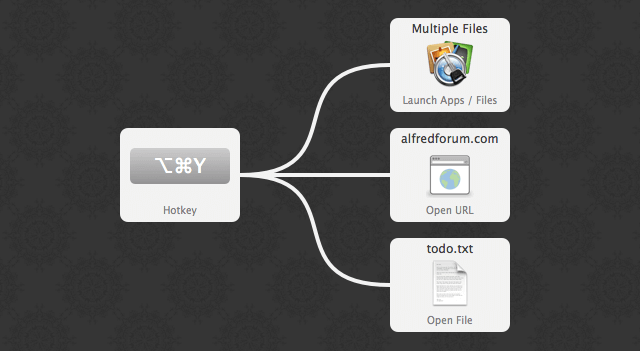
2. Use the Cmd, Ctrl & Alt modifier keys with Return
When using Alfred's search box, pressing return will open the application, file or website you've selected. Using modifier keys, your return key can do more. Press the modifier keys and you'll see your results' subtext change to an alternative action.

You can change what each modifier key does in the Advanced preferences tab.
3. Launch Alfred with a File Filter
Let's say you frequently search for PDF documents on your Mac. You can drastically speed up your search by using a hotkey to jump straight to a file filter workflow; No need to launch Alfred and type the keyword for your PDF search workflow.
Press your assigned hotkey to pop up the search box with the file filter already active. Your filter is identified by its icon on the left of the search box.

Download my PDF File Filter Workflow to see how simply you can create your own filters.
4. Large Type
Press Cmd + L to show any text in Alfred in large font across your screen. Handy for seeing phone numbers from across the room (or to share silly messages with everyone behind you in class!)
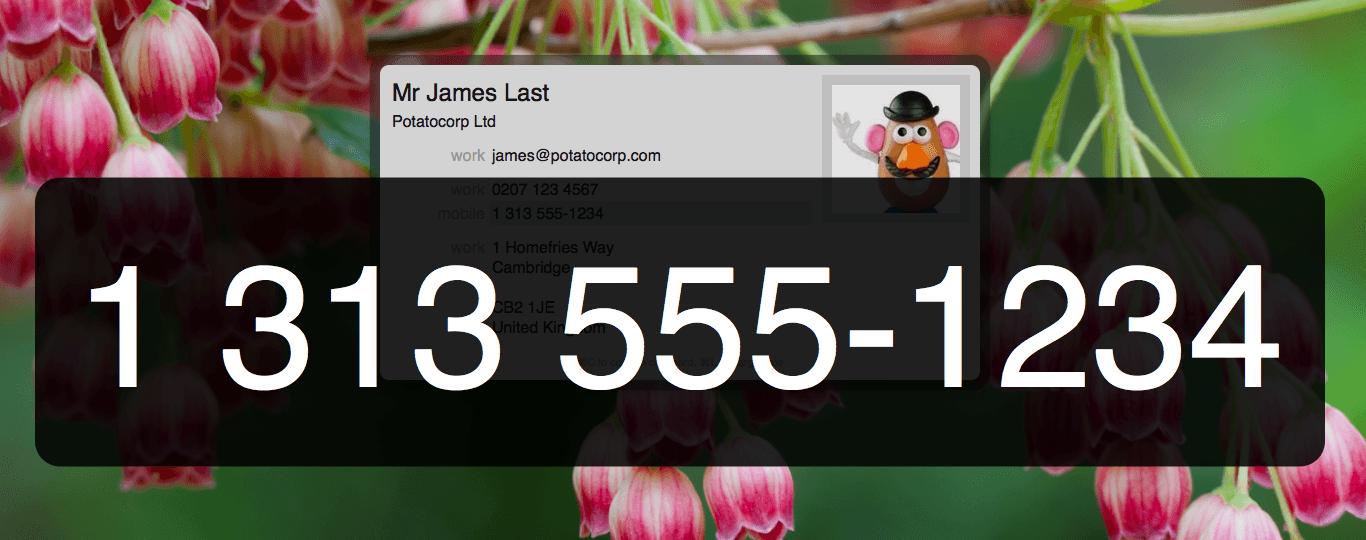
5. Paste as plain text
Paste text from the clipboard as plain text without showing the Clipboard Viewer with this handy little workflow.
6. File selection
Found a file in Finder you need to take action on? Select the file and pop up Alfred's File Action panel with the Cmd + Alt + hotkey.
You can even create your own actions and add them to this panel with a "File Action" workflow object for tasks you repeat often.
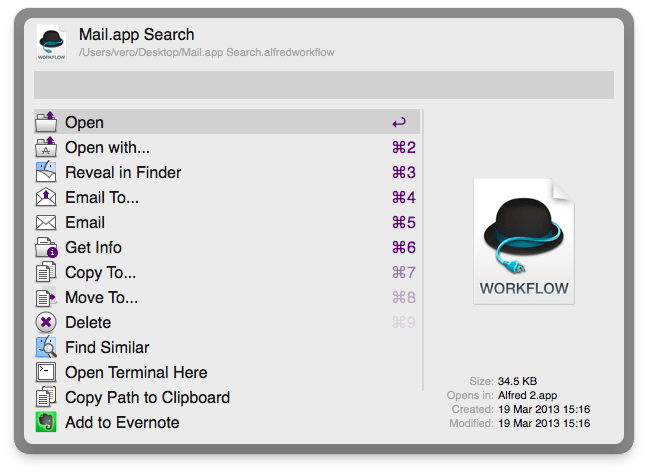
7. Speeding up hotkeys in workflows
This isn't a hotkey as such, but a way to make your existing workflow hotkeys perform their task even quicker.
To ensure that hotkeys always work smoothly on your Mac, Alfred waits a few milliseconds before letting the modifier keys (alt, cmd, ctrl) go before performing the action associated to your hotkey combination. If you want to speed this up, you can change the trigger behaviour to pass the modifier keys through and give you faster hotkeys.
Right-click on the hotkey field in your workflow object to show the hidden menu below.
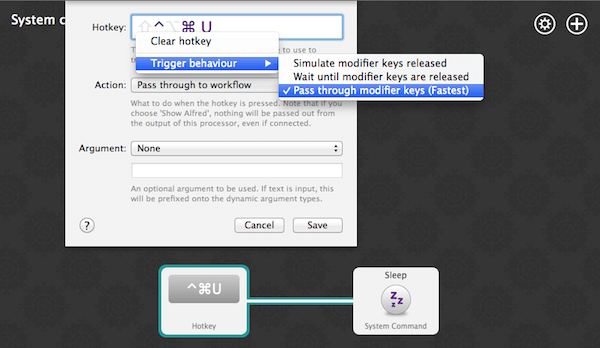
8. Get to the Preferences quickly
Like most OS X applications, Alfred uses the standard Cmd + , (Cmd + comma) to open its preferences, so you can quickly put into action the new things you've learned here.
9. Contextual hotkeys
When setting a hotkey in your workflow, you can specify when you want the hotkey to be active by including or excluding applications. Just drag the related apps in!
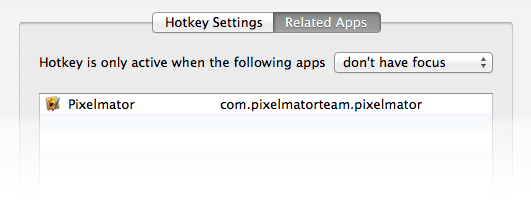
10. File Buffer
If you need to take action on multiple files at once, the File Buffer is the best way to stack up the files you need before performing an action on all of them.
Use Alt + Up arrow to add a file to the buffer from Alfred's results and Alt + Right arrow to take action on all of them. For the full set of File Buffer shortcuts, go to the File Search > Buffer preferences or have a look at the File Buffer support page.
Fancy discovering more great productivity features? Have a look at our Tutorials section for tips, tricks and workflows you'll love.











